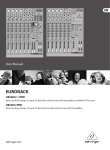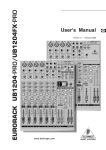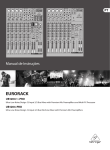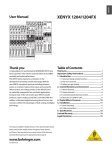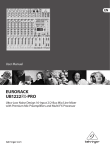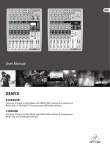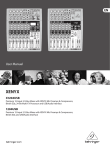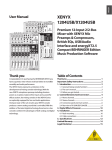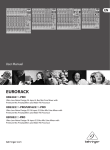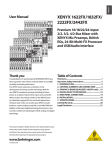Download Behringer Eurorack UB1204FX-Pro User manual
Transcript
User Manual EURORACK UB1204 -PRO Ultra-Low Noise Design 12-Input 2/2-Bus Mixer with Premium Mic Preamplifiers and Multi-FX Processor UB1204-PRO Ultra-Low Noise Design 12-Input 2/2-Bus Mic/Line Mixer with Premium Mic Preamplifiers 2 EURORACK UB1204FX-PRO/UB1204-PRO User Manual Table of Contents Thank you........................................................................ 2 Important Safety Instructions....................................... 3 Legal Disclaimer.............................................................. 3 Limited warranty............................................................. 3 1. Introduction................................................................ 4 1.1 General mixing console functions ................................ 4 1.2 The user’s manual................................................................ 4 1.3 Before you get started....................................................... 4 2. Control Elements and Connectors ........................... 5 2.1 Mono channels..................................................................... 5 2.2 Stereo channels.................................................................... 6 2.3 Connector panel and main section.............................. 7 2.4 Rear view of UB1204FX-PRO/UB1204-PRO................. 9 3. Digital Effects Processor.......................................... 10 4. Installation................................................................ 11 4.1 Rack mounting.................................................................... 11 4.2 Cable connections............................................................ 11 5. Specifications............................................................ 12 Thank you Congratulations! In purchasing the BEHRINGER EURORACK you have acquired a mixer whose small size belies its incredible versatility and audio performance. 3 EURORACK UB1204FX-PRO/UB1204-PRO User Manual Important Safety Instructions Terminals marked with this symbol carry electrical current of sufficient magnitude to constitute risk of electric shock. Use only high-quality professional speaker cables with ¼" TS or twist-locking plugs pre-installed. All other installation or modification should be performed only by qualified personnel. This symbol, wherever it appears, alerts you to the presence of uninsulated dangerous voltage inside the enclosure - voltage that may be sufficient to constitute a risk of shock. This symbol, wherever it appears, alerts you to important operating and maintenance instructions in the accompanying literature. Please read the manual. Caution To reduce the risk of electric shock, do not remove the top cover (or the rear section). No user serviceable parts inside. Refer servicing to qualified personnel. Caution To reduce the risk of fire or electric shock, do not expose this appliance to rain and moisture. The apparatus shall not be exposed to dripping or splashing liquids and no objects filled with liquids, such as vases, shall be placed on the apparatus. 9. Do not defeat the safety purpose of the polarized or grounding-type plug. A polarized plug has two blades with one wider than the other. A grounding-type plug has two blades and a third grounding prong. The wide blade or the third prong are provided for your safety. If the provided plug does not fit into your outlet, consult an electrician for replacement of the obsolete outlet. 10. Protect the power cord from being walked on or pinched particularly at plugs, convenience receptacles, and the point where they exit from the apparatus. 11. Use only attachments/accessories specified by the manufacturer. 12. Use only with the cart, stand, tripod, bracket, or table specified by the manufacturer, or sold with the apparatus. When a cart is used, use caution when moving the cart/apparatus combination to avoid injury from tip-over. 13. Unplug this apparatus during lightning storms or when unused for long periods of time. 14. Refer all servicing to qualified service personnel. Servicing is required when the apparatus has been damaged in any way, such as power supply cord or plug is damaged, liquid has been spilled or objects have fallen into the apparatus, the apparatus has been exposed to rain or moisture, does not operate normally, or has been dropped. 15. The apparatus shall be connected to a MAINS socket outlet with a protective earthing connection. 16. Where the MAINS plug or an appliance coupler is used as the disconnect device, the disconnect device shall remain readily operable. Caution These service instructions are for use by qualified service personnel only. To reduce the risk of electric shock do not perform any servicing other than that contained in the operation instructions. Repairs have to be performed by qualified service personnel. 1. Read these instructions. 2. Keep these instructions. 3. Heed all warnings. 4. Follow all instructions. 5. Do not use this apparatus near water. 6. Clean only with dry cloth. 7. Do not block any ventilation openings. Install in accordance with the manufacturer’s instructions. 8. Do not install near any heat sources such as radiators, heat registers, stoves, or other apparatus (including amplifiers) that produce heat. LEGAL DISCLAIMER TECHNICAL SPECIFICATIONS AND APPEARANCES ARE SUBJECT TO CHANGE WITHOUT NOTICE AND ACCURACY IS NOT GUARANTEED. BEHRINGER, KLARK TEKNIK, MIDAS, BUGERA, AND TURBOSOUND ARE PART OF THE MUSIC GROUP (MUSIC-GROUP.COM). ALL TRADEMARKS ARE THE PROPERTY OF THEIR RESPECTIVE OWNERS. MUSIC GROUP ACCEPTS NO LIABILITY FOR ANY LOSS WHICH MAY BE SUFFERED BY ANY PERSON WHO RELIES EITHER WHOLLY OR IN PART UPON ANY DESCRIPTION, PHOTOGRAPH OR STATEMENT CONTAINED HEREIN. COLORS AND SPECIFICATIONS MAY VARY FROM ACTUAL PRODUCT. MUSIC GROUP PRODUCTS ARE SOLD THROUGH AUTHORIZED FULLFILLERS AND RESELLERS ONLY. FULLFILLERS AND RESELLERS ARE NOT AGENTS OF MUSIC GROUP AND HAVE ABSOLUTELY NO AUTHORITY TO BIND MUSIC GROUP BY ANY EXPRESS OR IMPLIED UNDERTAKING OR REPRESENTATION. THIS MANUAL IS COPYRIGHTED. NO PART OF THIS MANUAL MAY BE REPRODUCED OR TRANSMITTED IN ANY FORM OR BY ANY MEANS, ELECTRONIC OR MECHANICAL, INCLUDING PHOTOCOPYING AND RECORDING OF ANY KIND, FOR ANY PURPOSE, WITHOUT THE EXPRESS WRITTEN PERMISSION OF MUSIC GROUP IP LTD. ALL RIGHTS RESERVED. © 2013 MUSIC Group IP Ltd. Trident Chambers, Wickhams Cay, P.O. Box 146, Road Town, Tortola, British Virgin Islands LIMITED WARRANTY For the applicable warranty terms and conditions and additional information regarding MUSIC Group’s Limited Warranty, please see complete details online at www.music-group.com/warranty. 4 EURORACK UB1204FX-PRO/UB1204-PRO User Manual 1. Introduction 1.2 The user’s manual The BEHRINGER EURORACK mixing console offers you premium-quality microphone preamplifiers with optional phantom power supply, balanced line inputs and the ability to connect external effects devices. Because of its extensive and carefully thought-out routing possibilities, your EURORACK lends itself equally to both live and studio use. The user’s manual is designed to give you both an overview of the controls, as well as detailed information on how to use them. In order to help you understand the links between the controls, wehave arranged them in groups according to their function. If you need to know more about specific issues, please visit our website at http://behringer.com, where you’ll find explanations of e.g. effects and dynamics applications. IMP “Invisible” Mic Preamp The microphone channels are fitted with BEHRINGER’s brand new high-end IMP INVISIBLE MIC PREAMPs that boast the following features: • 130 dB dynamic range for an incredible amount of headroom • A bandwidth ranging from below 10 Hz to over 200 kHz for crystal-clear reproduction of even the finest nuances • The extremely low-noise and distortionless circuitry guarantees absolutely natural and transparent signal reproduction • They are perfectly matched to every conceivable microphone with up to 60 dB gain and +48 volt phantom power supply and • They enable full utilisation of the greatly extended dynamic range of your 24-bit/192 kHz HD recorder, thereby maintaining optimal audio quality Additionally, your UB mixing console has an effects processor with 24-bit A/D and D/A converters included, which gives you 100 presets producing first-class reverb, delay and modulation effects plus numerous multi-effects in excellent audio quality. The mixing consoles of the PRO series feature a state of the art, integrated switch-mode power supply. One of the great advantages is that (compared to conventional circuits) a switch-mode power supply adapts to mains voltages between 100 and 240 volts automatically. Furthermore, due to its much greater efficiency, it consumes much less energy than a conventional power supply unit. Caution! ◊ We should like to draw your attention to the fact that extreme volumes may damage your hearing and/or your headphones or loudspeakers. Turn the MAIN MIX faders and phones control in the main section fully down before you switch on the unit. Always be careful to set the appropriate volume. 1.1 General mixing console functions A mixing console fulfils three main functions: • Signal processing: Preamplification, level adjustment, mixing of effects, frequency equalization ◊ The block diagram supplied with the mixing console gives you an overview of the connections between the inputs and outputs, as well as the associated switches and controls. For the moment, just try and trace the signal path from the microphone input to the aux send 1 connector. Don’t be put off by the huge range of possibilities; it’s easier than you think! If you look at the overview of the controls at the same time, you’ll be able to quickly familiarize yourself with your mixing console and you’ll soon be making the most of all its many possibilities. 1.3 Before you get started 1.3.1 Shipment Your mixing console was carefully packed in the factory to guarantee safe transport. Nevertheless, we recommend that you carefully examine the packaging and its contents for any signs of physical damage, which may have occurred during transit. ◊ If the unit is damaged, please do NOT return it to us, but notify your dealer and the shipping company immediately, otherwise claims for damage or replacement may not be granted. 1.3.2 Initial operation Be sure that there is enough space around the unit for cooling purposes and to avoid over-heating please do not place your mixing console on high-temperature devices such as radiators or power amps. The console is connected to the mains via the supplied cable. The console meets the required safety standards. Blown fuses must only be replaced by fuses of the same type and rating. ◊ Please note that all units must be properly grounded. For your own safety, you should never remove any ground connectors from electrical devices or power cables, or render them inoperative. ◊ Please ensure that only qualified people install and operate the mixing console. During installation and operation, the user must have sufficient electrical contact to earth, otherwise electrostatic discharges might affect the operation of the unit. 1.3.3 Online registration • Signal distribution: Summing of signals to the aux sends for effects Please register your new BEHRINGER equipment right after your purchase by visiting http://behringer.com and read the terms and conditions of our warranty carefully. • Mix: Setting the volume level, frequency distribution and positioning of the Should your BEHRINGER product malfunction, it is our intention to have it repaired as quickly as possible. To arrange for warranty service, please contact the BEHRINGER retailer from whom the equipment was purchased. Should your BEHRINGER dealer not be located in your vicinity, you may directly contact one of our subsidiaries. Corresponding contact information is included in the original equipment packaging (Global Contact Information/ European Contact Information). Should your country not be listed, please contact the distributor nearest you. A list of distributors can be found in the support area of our website (http://behringer.com). processing and monitor mix, distribution to one or several recording tracks, power amp(s), control room and 2-track outputs individual signals in the stereo field, level control of the total mix to match the recording devices/crossover/power amplifier(s). All other mixer functions can be included in this main function The interface of BEHRINGER mixing consoles is optimized for these tasks enabling you to easily keep track of the signal path. Registering your purchase and equipment with us helps us process your repair claims more quickly and efficiently. Thank you for your cooperation! 5 EURORACK UB1204FX-PRO/UB1204-PRO User Manual 2. Control Elements and Connectors 2.1.2 Equalizer This chapter describes the various control elements of your mixing console. All controls, switches and connectors will be discussed in detail. 2.1 Mono channels 2.1.1 Microphone and line inputs Fig. 2.2: The equalizer of the input channels All mono input channels include a 3-band equalizer. All bands provide boost or cut of up to 15 dB. In the central position, the equalizer is inactive. The upper (HIGH) and the lower band (LOW) are shelving filters that increase or decrease all frequencies above or below their cut-off frequency. The cut-off frequencies of the upper and lower band are 12 kHz and 80 Hz respectively. The mid band is configured as a peak filter with a center frequency of 2.5 kHz. 2.1.3 Aux sends Fig. 2.1: Connectors and controls of mic/line inputs MIC Each mono input channel offers a balanced microphone input via the XLR connector and also features a switchable +48 V phantom power supply for condenser microphones. ◊ Please mute your playback system before you activate the phantom power supply to prevent switch-on thumps being directed to your loudspeakers. Please also note the instructions in chapter 2.4.2 “Voltage supply, phantom power and fuse”. LINE IN Each mono input also features a balanced line input on a 1/4" connector. Unbalanced devices (mono jacks) can also be connected to these inputs. ◊ Please remember that you can only use either the microphone or the line input of a channel at any one time. You can never use both simultaneously! LOW CUT The mono channels of the mixing consoles have a high-slope LOW CUT filter for eliminating unwanted, low-frequency signal components (75 Hz, 18 dB/octave). GAIN Use the GAIN control to adjust the input gain. This control should always be turned fully counterclockwise whenever you connect or disconnect a signal source to one of the inputs. Fig. 2.3: The AUX SEND controls in the channel strips Aux sends take signals via a control from one or more channels and sum these signals to a so-called bus. This bus signal is sent to an aux send connector and then routed, for example, to an active monitor speaker or an external effects device. The return from an external effect can then be brought back into the console via the aux return connectors. For situations which require effects processing, the aux sends are usually switched post-fader so that the effects volume in a channel corresponds to the position of the channel fader. If this were not the case, the effects signal of the channel would remain audible even when the fader is turned to zero. When setting up a monitor mix, the aux sends are generally switched to pre-fader; i.e. they operate independently of the position of the channel fader. Both aux sends are mono, are sourced after the equalizer and offer up to +15 dB gain. ◊ If you press the MUTE/ALT 3-4 switch, aux send 1 is muted, provided that it is switched post-fader. However, this does not affect the aux send 2 of the UB1204FX-PRO. AUX 1 (MON) In the UB1204FX-PRO, aux send 1 can be switched pre-fader and is thus particularly suitable for setting up monitor mixes. In the UB1204-PRO, the first aux send is labeled MON and is permanently switched pre-fader. 6 EURORACK UB1204FX-PRO/UB1204-PRO User Manual PRE SOLO When the PRE switch is pressed, aux send 1 is sourced pre-fader. The SOLO switch (UB1204FX-PRO only) is used to route the channel signal to the solo bus (Solo In Place) or to the PFL bus (Pre Fader Listen). This enables you to monitor a channel signal without affecting the main output signal. The signal you hear is sourced either before (PFL, mono) or after (solo, stereo) both the pan control and the channel fader (see chapter 2.3.6 “Level meters and monitoring”). AUX 2 (FX) The aux send labeled FX is for sending to effects devices and is thus set up to be post-fader. In the UB1204FX-PRO, the FX send is routed directly to the built-in effects processor. ◊ If you wish to use the internal effects processor, the STEREO AUX RETURN 2 connectors should not be in use. ◊ UB1204FX-PRO: you can also connect an external effects processor to The channel fader determines the level of the channel signal in the main mix (or submix). 2.2 Stereo channels 2.2.1 Channel inputs aux send 2, however the internal effects module will be muted. 2.1.4 Routing switch, solo and channel fader Fig. 2.5: Stereo channel inputs and LEVEL switch Each stereo channel has two balanced line level inputs on 1/4" connectors for left and right channels. If only the connector marked “L” is used, the channel operates in mono. Stereo channels are designed to handle typical line level signals. Both inputs can also be used with unbalanced jacks. LEVEL For level matching, the stereo inputs feature a LEVEL switch which selects between +4 dBu and -10 dBV. At -10 dBV (home-recording level), the input is more sensitive than at +4 dBu (studio level). 2.2.2 Equalizer stereo channels Fig. 2.4: Panorama and routing controls The equalizer of the stereo channels is, of course, stereo. The filter characteristics and crossover frequencies are the same as those of the mono channels. A stereo equalizer is always preferable to two mono equalizers if frequency correction of a stereo signal is needed. There is often a discrepancy between the settings of the left and the right channels when using separate equalizers. PAN 2.2.3 Aux sends stereo channels The PAN control determines the position of the channel signal within the stereo image. This control features a constant-power characteristic, which means the signal is always maintained at a constant level, irrespective of position in the stereo panorama. In principle, the aux sends of the stereo channels function in just the same way as those of the mono channels. As aux send paths are always mono, the signal on a stereo channel is first summed to mono before it reaches the aux bus. MUTE/ALT 3-4 You can use the MUTE/ALT 3-4 switch to divert the channel from the main mix bus to the Alt 3-4 bus. This mutes the channel from the main mix. MUTE LED The MUTE LED indicates that the relevant channel is diverted to the submix (Alt 3-4 bus). CLIP LED The CLIP LED lights up when the input signal is driven too high. In this case, turn down the GAIN control and, if necessary, check the setting of the channel EQ. 2.2.4 Routing switch, solo and channel fader BAL The function of the BAL(ANCE) control corresponds to the PAN control in the mono channels. The balance control determines the relative proportion between the left and right input signals before both signals are routed to the main stereo mix bus. The MUTE/ALT 3-4 switch, the MUTE-LED, the CLIP-LED, the SOLO switch and the channel fader function in the same way as the mono channels. 7 EURORACK UB1204FX-PRO/UB1204-PRO User Manual 2.3 Connector panel and main section AUX SEND 2 Whereas it was useful to trace the signal flow from top to bottom in order to gain an understanding of the channel strips, we now look at the mixing console from left to right. The signals are, so to speak, collected from the same point on each of the channel strips and then routed to the main section all together. The AUX SEND 2 connector outputs the signal you picked up from the individual channels using the FX control. You can connect this to the input of an effects device in order to process the FX bus signal. Once an effects mix is created, the processed signal can then be routed from the effects device output back into the STEREO AUX RETURN connectors. 2.3.1 Aux sends 1 and 2 Fig. 2.6: AUX SEND controls of the main section A channel signal is routed to aux send bus 1 if the AUX 1 control is turned up on the corresponding channel. AUX SEND 1 (MON) The AUX SEND control MON acts as master control for aux send 1 and determines the level of the summed signal. In the UB1204FX-PRO, the MON control is called AUX SEND 1. 2.3.3 Stereo aux return connectors Fig. 2.8: Stereo aux return connectors STEREO AUX RETURN 1 The STEREO AUX RETURN 1 connectors generally serve as the return path for the effects mix generated using the post-fader aux send. This is where you connect the output signal of the external effects device. If only the left connector is used, the AUX RETURN automatically operates in mono. ◊ You can also use these connectors as additional line inputs. AUX SEND 2 (FX) STEREO AUX RETURN 2 Similarly, the FX control (AUX SEND 2) determines the level for aux send 2. The STEREO AUX RETURN 2 connectors serve as the return path for the effects mix generated using the FX control. If these connectors already function as additional inputs, you can route the effects signal back into the console via a different channel, with the added benefit that the channel EQ can be used to adjust the frequency response of the effects return signal. SOLO You can use the SOLO switch (UB1204FX-PRO only) to separately monitor the aux sends via the CONTROL ROOM/PHONES outputs and check these with the level meters. ◊ If you want to monitor the signal of just one AUX bus, none of the other SOLO SWITCHES should be pressed and the MODE switch must be in the SOLO position (not pressed down). 2.3.2 Aux send connectors 1 and 2 ◊ In this instance, the FX control of the channel being used as an effects return should be turned fully counterclockwise, otherwise feedback problems could occur! ◊ If you wish to use the internal effects processor, no connectors should be plugged into STEREO AUX RETURN 2. 2.3.4 Stereo aux return Fig. 2.7: Aux send connectors AUX SEND 1 If you use aux send 1 pre-fader, you would usually connect the AUX SEND 1 connector to monitors via a power amp (or an active monitor system). If you use aux send 1 post-fader, proceed as described under aux send 2. Fig. 2.9: Stereo aux return controls STEREO AUX RETURN 1 STEREO AUX RETURN 1 is a stereo control which determines the level of the signal in the main mix. If STEREO AUX RETURN 1 is used as effects return, you can add the effects signal to any “dry” channel signal. ◊ In this instance, the effects device should be set at 100% effect. 8 EURORACK UB1204FX-PRO/UB1204-PRO User Manual STEREO AUX RETURN MON 2.3.6 Level meter and monitoring The STEREO AUX RETURN MON control has a special function: it can be used to add an effect to a monitor mix. For example: Monitor mix with effect In this instance, the effects device should be set up as follows: AUX SEND 2 is connected to the L/Mono input of your effects device, while its outputs are connected to STEREO AUX RETURN 1. Connect the amplifier of your monitor system to AUX SEND 1. The AUX SEND 1 master control determines the volume of the monitor mix. You can now use the STEREO AUX RETURN MON control to adjust the level of the effects signal routed to the monitor mix. You can easily use the headphones distribution amplifier BEHRINGER POWERPLAY PRO HA4700/HA8000 to provide you with four (or eight with the HA8000) stereo headphone mixes for your studio. Fig. 2.11: Control room/phones section, level meter STEREO AUX RETURN 2 (FX) The 2-TRACK switch routes the signal from the 2-TRACK IN connectors to the level meter, the CONTROL ROOM OUT outputs and the PHONES connector this is a simple way to check recorded signals via monitor speakers or headphones. The STEREO AUX RETURN 2 control determines the level of signals fed into the AUX RETURN 2 connectors which are routed to the main mix. MAIN MIX/ALT 3-4 The MAIN MIX/ALT 3-4 switch routes the signal connected to STEREO AUX RETURN 2 to either main mix (not pressed) or submix (Alt 3-4, pressed). 2.3.5 2-Track input/2-Track output 2-TRACK ALT 3-4 Similarly, the ALT 3-4 switch routes the signal from the Alt 3-4 bus to the same path for monitoring purposes. MAIN MIX The MAIN MIX switch sends the main mix signal to the above-mentioned outputs and to the level meter. PHONES/CTRL RM Use this control to set control room output level and headphones volume respectively. 2-TRACK TO MAIN Fig. 2.10: 2-track connectors 2-TRACK INPUT The 2-TRACK INPUT RCA connectors are provided for connecting a 2 track machine (e.g. DAT recorder). They can also be used as stereo line input. Alternatively, the output signal of a second EURORACK or BEHRINGER ULTRALINK PRO MX882 can also be connected. If you connect a hi-fi amplifier with a source selection switch to the 2-TRACK INPUT, you can easily switch between additional sources (e.g. cassette recorder, CD player, etc.). 2-TRACK OUTPUT These connectors are wired in parallel with the MAIN OUT and carry the main mix signal (unbalanced). Connect the 2-TRACK OUTPUT to the inputs of your recording device. The final output level can be adjusted via the high-precision MAIN MIX fader. ◊ If you connect a compressor or a noise gate after the 2-track output, the faders will probably not be able to create a satisfactory fade-out effect. When the 2-TRACK TO MAIN switch is depressed, the 2-track input is routed to the main mix and thus serves as an additional input for 2-track machines. You can also connect MIDI instruments or other signal sources here that do not require any further processing. At the same time, this switch disables the main mix to 2-TRACK OUTPUT link. POWER The blue POWER LED indicates that the device is switched on. +48 V The red “+48 V” LED lights up when the phantom power supply is switched on. The phantom power supply is necessary for condenser microphones and is activated using the switch on the rear of the device. ◊ Please do not connect microphones to the mixer (or the stagebox/ wallbox) while the phantom power supply is switched on. Connect micro-phones before you switch on the power supply. In addition, the monitor/PA loudspeakers should be muted before you activate the phantom power supply. After switching on, wait approx. one minute to allow for system stabilization. 9 EURORACK UB1204FX-PRO/UB1204-PRO User Manual LEVEL METER PFL (UB1204FX-PRO only) The high-precision level meter accurately displays the appropriate signal level. The PFL LED indicates that the peak meter is set to PFL mode. LEVEL SETTING: PHONES When recording to a digital device, the recorder’s peak meter should not exceed 0 dB. This is because, unlike analog recordings, slightly excessive levels can create unpleasant digital distortion. You can connect headphones to this 1/4" TRS connector. The signal on the PHONES connection is sourced from the control room output. When recording to an analog device, the VU meters of the recording machine should reach approx. +3 dB with low-frequency signals (e.g. kick drum). Due to their inertia VU meters tend to display too low a signal level at frequencies above 1 kHz. This is why, for example, a Hi-Hat should only be driven as far as -10 dB. Snare drums should be driven to approx. 0 dB. ◊ The peak meters of your EURORACK display the level virtually independent of frequency. A recording level of 0 dB is recommended for all signal types. Fig. 2.12: PHONES connector 2.3.7 Alt 3-4 and main mix fader MODE (UB1204FX-PRO only) The MODE switch determines whether the channels’ SOLO switch operates as PFL (Pre Fader Listen) or as solo (Solo In Place). PFL To activate the PFL function, depress the MODE switch. The PFL function should, as a rule, be used for GAIN setting purposes. The signal is sourced pre-fader and assigned to the mono PFL bus. In the “PFL” setting, only the left side of the peak meter operates. Drive the individual channels to the 0 dB mark of the VU meter. Solo When the MODE switch is not depressed, the stereo solo bus is active. Solo is short for “Solo In Place”. This is the customary method for listening to an individual signal or to a group of signals. As soon as a solo switch is pressed, all channels in the control room (and headphones) that have not been selected are muted thereby retaining stereo panning. The solo bus can carry the output signals of the channel pan controls, the aux sends and the stereo line inputs. The solo bus is, as a rule, switched post-fader. ◊ The PAN control in the channel strip offers a constant power characteristic. This means that the signal is always at a constant level, irrespective of its position in the stereo panorama. If the PAN control is moved fully left or right from center, the level increases by 4 dB in that channel. This ensures that, when set in the center, the audio signal is not louder. For this reason, with the solo function activated (Solo in Place), audio signals from the channels with PAN controls that have not been moved fully to the left or right are displayed at a lower volume than in the PFL function. Fig. 2.13: Alt 3-4 and main mix fader Use the high-precision quality faders to control the output level of the Alt 3-4 subgroup and main mix. 2.4 Rear view of UB1204FX-PRO/UB1204-PRO 2.4.1 Main mix outputs, alt 3-4 outputs and control room outputs As a rule, solo signals are monitored via the control room outputs and headphones connector and are displayed by the level meters. If a solo switch is pressed, the signals from the 2-TRACK INPUT, Alt 3-4 and main mix are blocked from the control room outputs, the headphone connector and the level meter. MAIN SOLO (UB1204FX-PRO only) The MAIN SOLO LED lights up as soon as a channel or aux send solo switch is pressed. The MODE switch also has to be set at “Solo”. Fig. 2.14: Main mix outputs, Alt 3-4 outputs and control room outputs MAIN OUTPUTS The MAIN outputs carry the MAIN MIX signal and are on balanced XLR connectors with a nominal level of +4 dBu. 10 EURORACK UB1204FX-PRO/UB1204-PRO User Manual ALT 3-4 OUTPUTS 3. Digital Effects Processor The ALT 3-4 outputs are unbalanced and carry the signals of the channels that you have assigned to this group using the MUTE switch. This can be used to route a subgroup to a further mixing console for example, or or it could be used as a recording output working in tandem with the main output. This means you could record to four tracks simultaneously. The icing on the cake, so to speak, is that you could connect Y-cables to these four outputs and then connect your 8-track recorder in such a way that you have 2 x 4 tracks (e.g. channel 1 feeds track 1 and track 2, etc.). In the first recording pass, you record on tracks 1, 3, 5 and 7 and in the second pass, on tracks 2, 4, 6 and 8. CONTROL ROOM OUTPUTS The control room output is normally connected to the monitor system in the control room and provides the stereo mix or, when required, the solo signal. 2.4.2 Voltage supply, phantom power and fuse Fig. 3.1: Digital effects module (only UB1204FX-PRO) 24-BIT MULTI-EFFECTS PROCESSOR Fig. 2.15: Voltage supply and fuse FUSE HOLDER The console is connected to the mains via the cable supplied which meets the required safety standards. Blown fuses must only be replaced by fuses of the same type and rating. IEC MAINS RECEPTACLE The mains connection is via a cable with IEC mains connector. An appropriate mains cable is supplied with the equipment. POWER Use the POWER switch to power up the mixing console. PHANTOM The PHANTOM switch activates the phantom power supply for the XLR connectors of the mono channels which is required to operate condenser microphones. The red +48 V LED lights up when phantom power is on. As a rule, dynamic microphones can still be used with phantom power switched on, provided that they are wired in a balanced configuration. In case of doubt, contact the microphone manufacturer! ◊ After the phantom power supply has been switched on, do not connect microphones to the mixer (or the stagebox/wallbox). Connect the microphones before you switch phantom power on. In addition, the monitor/PA loudspeakers should be muted before activating the phantom power supply. After switching on, wait approx. one minute to allow the system to stabilize. ◊ Caution! You must never use unbalanced XLR connectors (PIN 1 and 3 connected) on the MIC input connectors if you want to use the phantom power supply. SERIAL NUMBER Please note the important information on the serial number given in chapter 1.3.3. Here you can find a list of all presets stored in the multi-effects processor. This built-in effects module produces high-grade standard effects such as reverb, chorus, flanger, delay and various combination effects. The integrated effects module has the advantage of requiring no wiring. This way, the danger of creating ground loops or uneven signal levels is eliminated at the outset, completely simplifying the handling. You can route signals to the effects processor via aux send 2 in the channels and the aux send 2 master control. The built-in stereo effects processor has the advantage that it does not need to be cabled up. This eliminates any danger of hum or level mismatch right from the start providing straight-forward operation. These effect presets are designed to be added to dry signals. If you move the STEREO AUX RETURN FX control, you mix the channel signal (dry) and the effect signal. You can control the balance between the two signals with the channel fader and the STEREO AUX RETURN FX control. FX FOOTSW Connect a standard foot switch to the foot switch connector; use this to switch the effects processor on and off. A dot at the bottom of the display indicates if the effects processor is muted via the foot switch. ◊ On the following page, you will find an illustration showing how to connect your foot switch correctly. LEVEL The LED level meter on the effects module should display a sufficiently high level. Take care to ensure that the clip LED only lights up at peak levels. If it is lit constantly, you are overloading the effects processor and this could cause unpleasant distortion. The FX control (AUX SEND 2) determines the level that reaches the effects module. PROGRAM You can select the effect preset by turning the PROGRAM control. The display flashes the number of the current preset. To recall the selected preset, press the button; the flashing stops. You can also recall the selected preset with the foot switch. 11 EURORACK UB1204FX-PRO/UB1204-PRO User Manual 4. Installation 4.2.1 Audio connections 4.1 Rack mounting Please use commercial RCA cables to wire the 2-track inputs and outputs. The packaging of your mixing console contains two 19" rack mount wings which can be installed on the side panels of the console. Before you can attach the rack mount wings to the mixing console, you need to remove the screws holding the left and right side panels. Use these screws to fasten the two wings onto the console, being careful to note that each wing fits a specific side. With the rack mount wings installed, you can mount the mixing console in a commercially available 19" rack. Be sure to allow for proper air flow around the unit, and do not place the mixing console close to radiators or power amps, so as to avoid overheating. ◊ Only use the screws holding the mixing console side panels to fasten the 19" rack mounts. 4.2 Cable connections You will need a large number of cables for the various connections to and from the console. The illustrations below show the wiring of these cables. Be sure to use only high-grade cables. ¼" TS footswitch connector strain relief clamp sleeve tip You can, of course, also connect unbalanced devices to the balanced input/outputs. Use either mono plugs, or ensure that ring and sleeve are bridged inside the stereo plug (or pins 1 & 3 in the case of XLR connectors). ◊ Caution! You must never use unbalanced XLR connectors (pin 1 and 3 connected) on the MIC inputs if you intend to use the phantom power supply. Balanced use with XLR connectors 2 1 3 input 1 = ground/shield 2 = hot (+ve) 3 = cold (-ve) 1 2 3 output For unbalanced use, pin 1 and pin 3 have to be bridged Fig. 4.2: XLR connections Unbalanced ¼" TS connector sleeve pole 1/ground strain relief clamp sleeve tip tip pole 2 The footswitch connects both poles momentarily sleeve (ground/shield) Fig. 4.1: 1/4" TS connector for foot switch tip (signal) Fig. 4.3: 1/4" TS connector 12 EURORACK UB1204FX-PRO/UB1204-PRO User Manual Balanced ¼" TRS connector strain relief clamp sleeve ring tip 5. Specifications Mono Inputs Microphone Inputs (IMP “Invisible” Mic Preamp) Type sleeve ground/shield ring cold (-ve) tip hot (+ve) For connection of balanced and unbalanced plugs, ring and sleeve have to be bridged at the stereo plug. Fig. 4.4: 1/4" TRS connector ¼" TRS headphones connector strain relief clamp sleeve ring tip sleeve ground/shield Mic E.I.N. (20 Hz - 20 kHz) @ 0 Ω source resistance -134 dB / 135.7 dB A-weighted @ 50 Ω source resistance -131 dB / 133.3 dB A-weighted @ 150 Ω source resistance -129 dB / 130.5 dB A-weighted Frequency response <10 Hz - 150 kHz (-1 dB), <10 Hz - 200 kHz (-3 dB) Gain range +10 to +60 dB Max. input level +12 dBu @ +10 dB gain Impedance approx. 2.6 kΩ balanced Signal-to-noise ratio 110 dB / 112 dB A-weighted (0 dBu In @ +22 dB gain) Distortion (THD+N) 0.005% / 0.004% A-weighted Line Input Type 1/4" TRS connector electronically balanced Impedance approx. 20 kΩ balanced approx. 10 kΩ unbalanced Gain range -10 to +40 dB Max. input level 30 dBu ring right signal tip left signal Fig. 4.5: 1/4" TRS connector for headphones XLR, electronically balanced, discrete input circuit Fade-Out Attenuation1 (Crosstalk Attenuation) Main fader closed 90 dB Channel muted 89.5 dB Channel fader closed 89 dB Frequency Response Microphone Input to Main Out <10 Hz - 90 kHz +0 dB / -1 dB <10 Hz - 160 kHz +0 dB / -3 dB Stereo Inputs Type 1/4" TRS connector, electronically balanced Impedance approx. 20 kΩ Max. input level +22 dBu 13 EURORACK UB1204FX-PRO/UB1204-PRO User Manual EQ Mono Channels Main Mix System Data2 Low 80 Hz / ±15 dB Mid 2.5 kHz / ±15 dB High 12 kHz / ±15 dB EQ Stereo Channels Low 80 Hz / ±15 dB Mid 2.5 kHz / ±15 dB High 12 kHz / ±15 dB Aux Sends Type 1/4" TS connector, unbalanced Impedance approx. 120 Ω Max. output level +22 dBu Noise Main mix @ -∞, Channel fader @ -∞ -105 dB / -108 dB A-weighted Main mix @ 0 dB, Channel fader @ -∞ -95 dB / -97 dB A-weighted Main mix @ 0 dB, Channel fader @ 0 dB -82.5 dB / -85 dB A-weighted Power Supply Mains voltage 100 to 240 V~, 50/60 Hz Power consumption 40 W Fuse 100 - 240 V~: T 1.6 A H Mains connection Standard IEC receptacle Physical Stereo Aux Returns UB1204FX-PRO Type 1/4" TRS connector, electronically balanced Impedance approx. 20 kΩ bal. / 10 kΩ unbal. Max. input level +22 dBu Main Outputs Type XLR, electronically balanced Impedance approx. 240 Ω bal. / 120 Ω unbal. Max. output level +28 dBu Control Room Outputs Type 1/4" TS connector, unbal. Impedance approx. 120 Ω Max. output level +22 dBu Headphones Output Type 1/4" TRS connector, unbalanced Max. output level +19 dBu / 150 Ω (+25 dBm) DSP 24-bit Texas Instruments Converter 24-bit Sigma-Delta, 64/128-times oversampling Sampling rate 40 kHz Dimensions (H x W x D) approx. 97 x 247 x 334 mm (3 7/8 x 9 11/16 x 13 5/32") Weight (Net) approx. 3.9 kg (8.6 lbs) UB1204-PRO Dimensions (H x W x D) approx. 97 x 247 x 328 mm (3 7/8 x 9 11/16 x 13") Weight (Net) approx. 3.7 kg (8.1 lbs) Measuring conditions: 1: 1 kHz rel. to 0 dBu; 20 Hz - 20 kHz; line input; main output; unity gain. 2: 20 Hz - 20kHz; measured at main output. Channels 1 - 4 unity gain; EQ flat; all channels on main mix; channels 1/3 as far left as possible, channels 2/4 as far right as possible. Reference = +6 dBu. BEHRINGER is constantly striving to manintain the highest professional standards. As a result of these efforts, modifications may be made from time to time to existing products without prior notice. Specifications and appearance may differ from those listed or illustrated. 14 EURORACK UB1204FX-PRO/UB1204-PRO User Manual FEDERAL COMMUNICATIONS COMMISSION COMPLIANCE INFORMATION EURORACK UB1204FX-PRO/ UB1204-PRO Responsible Party Name: MUSIC Group Services US Inc. Address: 18912 North Creek Parkway, Suite 200 Bothell, WA 98011, USA Phone Number: +1 425 672 0816 EURORACK UB1204FX-PRO/UB1204-PRO complies with the FCC rules as mentioned in the following paragraph: This equipment has been tested and found to comply with the limits for a Class B digital device, pursuant to part 15 of the FCC Rules. These limits are designed to provide reasonable protection against harmful interference in a residential installation. This equipment generates, uses and can radiate radio frequency energy and, if not installed and used in accordance with the instructions, may cause harmful interference to radio communications. However, there is no guarantee that interference will not occur in a particular installation. If this equipment does cause harmful interference to radio or television reception, which can be determined by turning the equipment off and on, the user is encouraged to try to correct the interference by one or more of the following measures: • Reorient or relocate the receiving antenna. • Increase the separation between the equipment and receiver. • Connect the equipment into an outlet on a circuit different from that to which the receiver is connected. • Consult the dealer or an experienced radio/TV technician for help. This device complies with Part 15 of the FCC rules. Operation is subject to the following two conditions: (1) this device may not cause harmful interference, and (2) this device must accept any interference received, including interference that may cause undesired operation. Important information: Changes or modifications to the equipment not expressly approved by MUSIC Group can void the user’s authority to use the equipment. We Hear You















